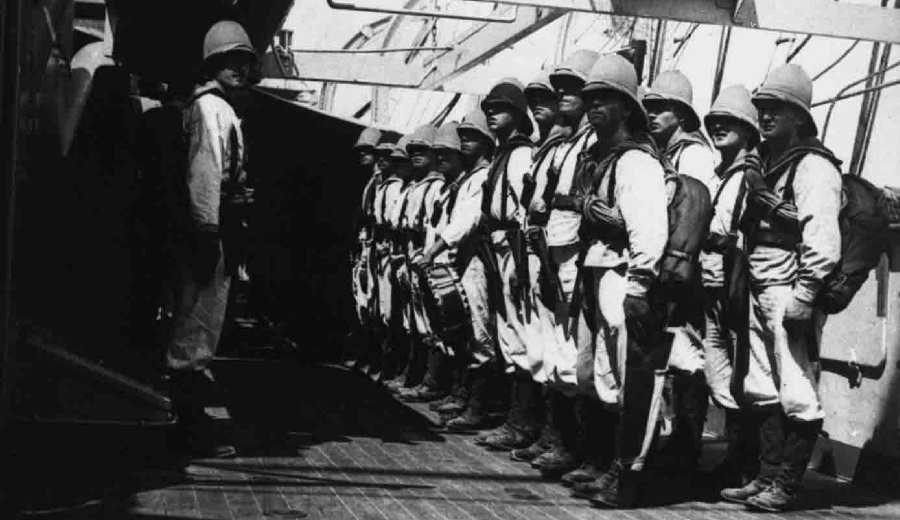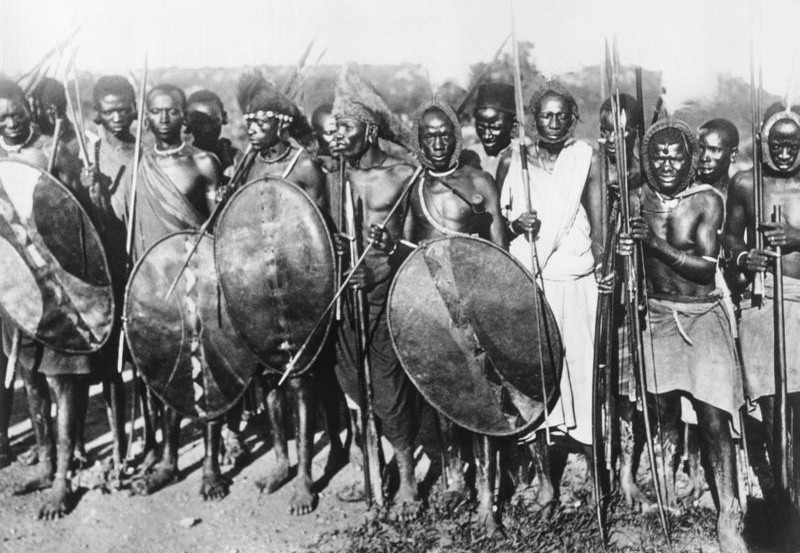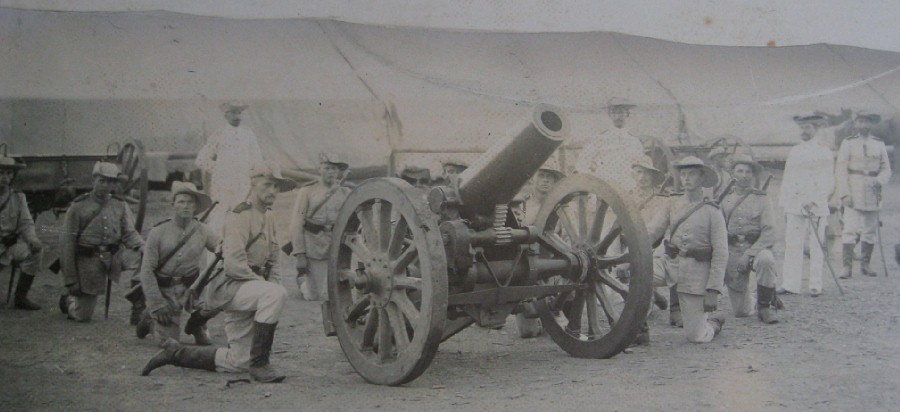|
Forces in the German Colonies
Unlike Britain and France, Germany never stationed regular
army units in the their colonies nor did they build up large colonial armies
for use abroad. The forces they did have were relatively small (even by
comparison with those of the Belgian and Portuguese colonies), and were intended only
for police work and quelling local rebellions. In the
case of large rebellions, additional reinforcements were sent from Germany or
nearby warships. The military forces available to each colony
came from several potential sources described below. Each of these sources will be
discussed in more detail in each colony's own introduction.
Schutztruppe
The larger German colonies (German South West Africa, German East Africa and
Cameroon) had their own regular colonial troops known as "Schutztruppe".
A colony was referred to in German as a "Schutzgebiet" (or literally a
Protectorate), so the soldiers stationed there were referred to as "Schutztruppe"
(literally meaning Protection-troop). The Schutztruppe
were the backbone of defence and counter-rebellion forces of the three main
African colonies. In German East Africa and Cameroon the
Schutztruppe consisted of German Officers and NCOs with African other ranks. The
Schutztruppe of German South West Africa consisted exclusively of German
officers and other ranks.
The Schutztruppe of all three colonies were trained up to
high standards. The German officers and NCOs in them usually having volunteered
for overseas service and already having previously served in the regular German
army or navy. The African soldiers in the Schutztruppe of German East Africa and
Cameroon were also drilled and trained up to regular German army standards. They
were amongst the best African troops on the continent being well armed, highly
motivated and with relatively good pay (as compared with other European colonial
armies). These African troops were usually recruited from outside the territory
or area in which they served. This made them less likely to side with the local
people in the event of a rebellion. The Schutztruppe of all three colonies were formed into company
sized formations, stationed in small forts spread across each colony.
The Schutztruppe came under the control of the Imperial Colonial
Ministry ("Reichskolonialamt") in Berlin rather than the Ministry of War
and therefore did not always follow the same procedure or uniform regulations
that governed the regular German army although similarities did exist. The
Schutztruppe for each colony were formed separately from each other between the
late 1880's and early 1890's and for a while no uniformity existed between them.
Between 1894-96 an element of cohesive organisation was introduced especially in
areas of training, uniforms and cross posting of German officers and NCOs.
Each colony's troops however, still
retained differences based on local conditions.
Recommended External Link -
Traditionsverband

The Kaiser Inspects the South West African Schutztruppe,
Potsdam 1894
Photo ©
Frankfurt University Koloniales Bildarchiv
Polizeitruppe
Each colony had police troops ("Polizeitruppe") officered by Germans with
the rank and file usually recruited from the local populace (the exception was
German South West Africa which instead had a state police force or "Landespolizei", made up mainly of German officers and other ranks). The Germans in the
colonial police were usually recruited from police forces in Germany rather than from
the army. They did not necessarily have military training and were classed as
officials ("Beamte") rather than military personnel. The
African or Pacific Islander
other ranks were however regarded as military personnel ("Polizei-Soldaten").
Although they were not trained up to full Schutztruppe or German army standards,
the Polizeitruppe did recieve some military training and were fully armed with rifles and machine guns.
These colonial police were used to collect taxes, quell minor rebellions
and keep law and order in peacetime. On some Pacific Islands they also doubled
as postmen. When the First World War broke out the police forces in East Africa,
South West Africa and Cameroon were incorporated into the Schutztruppe, while
the police forces in Togo and New Guinea formed the main part of the German
defences.
Recommended External Link -
Polizeigeschichte

New Guinea Polizeitruppe
on Parade
Photo ©
Frankfurt University Koloniales Bildarchiv
Imperial Navy
One of the main strategic uses of the colonies was as bases for the Imperial German navy
("Kaiserliche Marine") with vital coaling
depots and large radio stations
capable of communicating with their ships across the Atlantic, Indian and
Pacific Oceans. As such all the colonies received regular visits from German warships which
also at times of rebellion could provide artillery support and landing parties.
Recommended External Link -
Kaiserliche Marine
The German-leased territory of Kiaochow in China was
unique as a
colony in that it was governed and defended by the navy and naval troops (rather than the
colonial office and the Schutztruppe). The port of Tsingtao served as the base of the German East Asian fleet.
Recommended External Link -
Tsingtau Info
Some colonies also had their own non-military ships, separate from the
Imperial navy. These vessels came under the control of the colonial governors
and were officered by Germans with locally recruited crews. They were not
intended for military use although they could be used to ferry supplies and
troops in times of war.
Recommend External Link - Axis History Forum Discussion on the
Nachtigal

Naval Landing Party SMS Königsberg, East Africa 1914
Photo ©
Frankfurt University Koloniales Bildarchiv
Marine Infantry
The German marine infantry battalions ("Seebataillone") were
part of the Imperial navy but were trained and uniformed in the style of the
Imperial army (but with additional training at sea).
The I. and II. Seebataillone were based in Germany but were ready to be shipped
out to the colonies to assist in times of major rebellions (such as the Dahomey
Slaves Rebellion in Cameroon in 1893, the Boxer Rebellion in China in 1900, the
Herero Rebellion in South West Africa 1904 and the Maji-Maji Rebellion in East
Africa in 1905). The III. Seebataillon was
permanently based in Tsingtao along with a Marine Field Artillery Battery.
Recommended External Link -
Marine Infanterie

Marine Field Battery on the beach
at Tsingtao
Photograph from Bundesarchiv
/
WikiCommons
Reservists
Prussian civilians had been liable for conscription since the Napoleonic Wars.
From 1893 the periods set for service in the home army were two years with the
full time regular army (or navy) followed by five with the reserve (or naval
reserve). After service in the reserve, German civilians served twelve years with the
Landwehr and another six with the Landsturm until they were 45 years old. From
1912 onwards German civilians living in the colonies came under the same
reservist call-up laws as in Germany.
In practice most Germans living in the colonies had already served their two
years in the regular army. Service and training in the Reserve (and Landwehr and
Landsturm) was not full time like in the regular army and usually only required
a small amount of time spent training or on exercise each year. In the colonies
this was rarely put into practice except in times of serious rebellion or war.
Reservists were called up during the Herero Rebellion in South West Africa, the
Maji-Maji Rebellion in German East Africa and during the Boxer Rebellion in
China German civilians formed an 800 strong "Kommando" Detachment.
When the First World War broke out each of the German colonies, therefore had
numbers of farmers, traders and other colonists, most with some military
training available for action. The Schutztruppe and colonial governments also
had administrative personnel such as governor's staff, garrison officers, depot
staff, paymasters, train crews, boat crews, vets, doctors, hospital staff and in
the case of German South West Africa, a camel stud farm staff. These were either
kept in their useful jobs in wartime or transferred to reservist units. Many Germans even travelled vast distances across
Africa or China to get to the nearest colony to volunteer their services.
Native Irregulars
All the colonies recruited irregulars as scouts, guides and light infantry from
the local populations. Often in Africa, the Germans would encourage friendly
tribes to serve alongside them against their rebellious neighbours. Local civilians were also employed by the Schutztruppe
and colonial forces as servants, cooks, transport drivers and for many other
tasks including working as aircraft ground crews. The African colonies (especially German East Africa, Cameroon and
Togo) also relied heavily on large numbers of native porters for transportation.
 African Warriors in German Service
African Warriors in German Service
Photo by Paul
Hoffmann from Bundesarchiv /
WikiCommons
Expeditionary Corps
If the need for overseas action called for more than the local Schutztruppe or
Polizeitruppe could contain then naval help and the Seebataillone were called
upon. If the perceived need outweighed these forces then expeditions were
formed in Germany from regular army personnel for service overseas. Prior to the
First World War these troops were formed into newly established units rather
than sending existing army units overseas as the other European powers did. The
main reason for this was that the peacetime command of the German armies lay
with the different kingdoms that made up the German Empire and that they would
then have to have the approval not only of the Reichstag parliament in Berlin
but also of the individual kingdoms and their respective war ministries leading
to time consuming debates. These newly formed Expeditions therefore came under
direct imperial command as did the Schutztruppe, Seebataillone and imperial
navy.
In 1900 the East Asian Expeditionary Corps was formed from volunteers from
the regular imperial army
and sent to China to quell the Boxer Rebellion. It arrived too late to seen the
main actions of the campaign but elements of it remained in occupation until
1909. In 1904 another expeditionary corps was formed for service in the Herero Rebellion. It was made
up of volunteers and conscripts from the regular Imperial army in Germany formed
into new Schutztruppe units.
During the First World War two expeditionary
forces, entitled Pascha I and II (the latter also known as the
"Asienkorps") were formed from regular army units to assist the
Ottoman army in Sinai and Palestine. A further expeditionary corps was sent to
Georgia in 1918 to secure the newly declared republic and its oilfields.

Heavy Artillery of the East Asian Expeditionary Corps to China in 1900
Photo © Peter Klein Air Power
The first use of aircraft in German colonial
warfare was the Schutztruppe's limited use of balloon mounted aerials for
telegraphic communications during the Herero Rebellion. Manned
aircraft were not used in combat in the colonies until the First World War. German South West Africa,
German East Africa and Tsingtao each had one or two aeroplanes. They were mainly used
for reconnaissance and in all cases were out of action by mid 1915.
Recommended External Link - Axis History Forum Discussion on
Airpower in the Colonies |